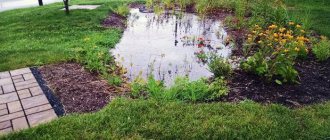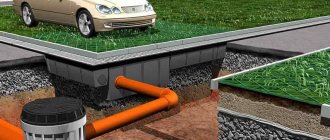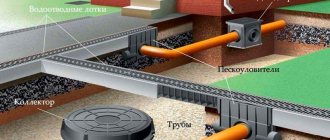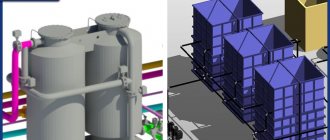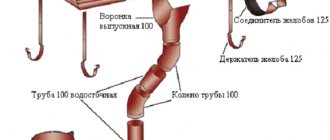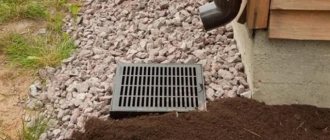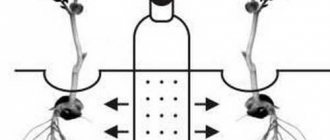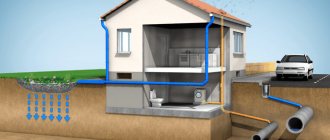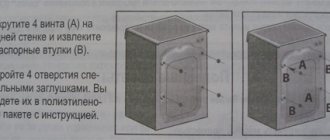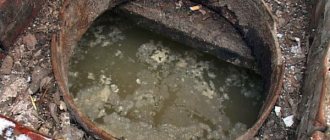Is this liquid household waste?
According to the Decree of the Government of the Russian Federation dated February 10, 1997 No. 155 “On approval of the rules for the provision of services for the removal of liquid household waste”
“liquid household waste” - household wastewater generated as a result of the life of the population and discharged into structures and devices that are not connected (technologically not connected) to the centralized drainage system and are intended for the reception and accumulation of wastewater.
Let's refer to the Federal Waste Classification Catalog (FKKO), section 7:
“WASTE DURING WATER SUPPLY, WATER DISPOSAL, ACTIVITIES FOR COLLECTION, PROCESSING, RECYCLING, DISPOSAL, AND WASTE DISPOSAL
(except for waters that are removed by treating them at treatment facilities and then sending them to the recycling water supply system or discharging them into water bodies)
Thus, wastewater is generated if water disposal occurs:
- through treatment facilities with further discharge into the circulating water supply system
- discharge into a water body
- through a centralized drainage system.
In other cases it is liquid household waste.
Lisichnikova Lyudmila
Ask a Question
There are a lot of articles on the Internet criticizing the method of classifying wastewater or waste depending on the method of disposal. Below in the article there are 2 clarifications on this issue.
Industrial wastewater
Nature of wastewater
While domestic wastewater has more or less the same characteristics, the wide variety of industrial wastewater requires special study of them in each industry, and often the use of special technologies.
To make decisions about the needs and use of certain methods of treating industrial wastewater, in addition to the necessary data on the analysis of their composition, information on production technologies and organization of water supply systems is essential.
| Characteristics of wastewater from non-ferrous metallurgy plants | |
| Characteristics of wastewater from ferrous metallurgy plants | |
| Characteristics of wastewater from pulp and paper mills (PPM) | |
| Characteristics of energy industry wastewater | |
| Characteristics of wastewater from food industry enterprises | |
| Characteristics of wastewater from sawmills and wood processing plants, furniture factories | |
| Characteristics of light industry wastewater | |
| Characteristics of wastewater from mining and chemical production | |
| Characteristics of domestic wastewater | |
| Characteristics of storm wastewater | |
| Characteristics of wastewater from the heat and power industry | |
Origin of wastewater
In industry, four large categories of SV can be distinguished:
1. Wastewater from industrial processes - generated as a result of industrial processes from the contact of water with gases, liquids or solids. Flows of this wastewater may be continuous or intermittent.
2. Special wastewater
Some wastewaters should be separated into separate streams:
- to carry out specific processing, possibly with the recovery of some components and/or water and their return to production;
- for directing to intermediate storage tanks, in order to then evenly introduce them into the general wastewater treatment line (possibly with preliminary neutralization).
These include:
- waste solutions from galvanic and pickling baths, waste soda solutions, ammonia water from a coking plant;
- condensates in paper production, mother liquors in the agro-food and chemical industries;
- toxic and concentrated wastewater discharges,
3. Auxiliary system wastewater
- Domestic wastewater from canteens, etc.
- Water from heating systems (boiler drains, ...),
- Liquid sludge from make-up water treatment,
- Drains from cooling systems,
4. Accidental wastewater releases
You should not forget about them, since they can arise as a result of:
- emergency leakage of production products during their movement or storage;
- draining water after washing production premises or equipment;
- drainage of contaminated water, including after rainstorms, causing hydraulic overload of treatment facilities.
- Such wastewater is often directed to a separate “observation basin.”
General characteristics of wastewater
To properly design ESW treatment facilities, it is necessary to have the following information:
- types, volumes and cycles of production, raw materials consumed;
- composition of water supplied to the enterprise;
- the possibility of separating wastewater flows and/or creating circulating water supply systems;
- daily wastewater consumption by category;
- average hourly and maximum wastewater flows (duration and frequency by category);
- average and maximum (frequency and duration) pollution flow by pollutant category and for specific pollution in a given industry.
It is often useful to know about secondary pollution of wastewater, even accidental, which can seriously disrupt the operation of some installations at wastewater treatment plants (adhesives, resins, fibers, oils, sand, toxic compounds, etc.). As part of the design of a new plant, this information, collected after production analysis, is compared with data obtained from similar, existing plants. It is often necessary to know the composition of water supplied to production.
Types of production and features of waste:
Agricultural and food industry:
The entire agro-food industry is characterized by the following characteristics of wastewater: the pollution is mainly organic and biodegradable, with a general tendency towards rapid souring and fermentation. All of these wastewaters are treated biologically, although they may be deficient in nitrogen and phosphorus.
Each of the industries listed below has a specific production waste, and as a result requires the development of an individual technological scheme for treatment facilities:
- Pig farms
- Slaughterhouses and meat industry
- Dairies
- Brewing
- Potato processing, starch factories
- Starch production
- Wastewater from other sectors of the agri-food industry:
Textile industry
The textile industry is very diverse, so it is easier to characterize the main sources of pollution than the wastewater itself:
- Washing and combing wool
- Pre-treatment for finishing fabrics
- Fabric finishing
- Laundry factories
Pulp and paper mills
Pulp and paper enterprises usually consist of two industries: the production of paper pulp and the production of paper, the wastewater from which contains various contaminants and requires appropriate treatment. In some enterprises these two processes are integrated.
- Paper pulp production
- Cardboard and paper factories
Oil industry:
In the oil industry, four types of activities can be distinguished, during which different types of specific wastewater and discharges are produced.
1. Oil production - Discharges include produced waters extracted along with crude oil, as well as sediments from well drilling.
2. Transport of crude oil and petroleum products - At loading terminals, it is necessary to collect and treat ballast water discharged from tankers, and sometimes wash water.
3. Petroleum Refineries - A distinction is made between simple petroleum refining, based on the distillation of crude oil, and petroleum refining.
The common pollution in the three activities mentioned above is hydrocarbons. The proportion of soluble organic contaminants (oxidized compounds, phenols, aldehydes) during the cracking process increases, while the distillation of heavy and sour oil increases sulfide contamination.
4. Petrochemicals – There are three types of industrial complexes producing basic petrochemical products:
- synthetic gas complexes.
- olefin complexes.
- aromatic complexes.
Ferrous metallurgy:
- Getting coke
- Etching
- Gas flushing
- Rental
In ferrous metallurgy, four types of activities are distinguished: some produce wastewater that is highly contaminated with dissolved substances (coke plants, some hot rolling shops) and therefore requires careful processing; in others, wastewater with a high content of suspended matter (oxides, explosives, insoluble hydrocarbons) is formed, which can be almost completely used in the circulating water supply system.
Automotive and aviation industry
Depending on the profile of the enterprise, discharges can be as follows:
- water cutting fluid drains;
- wastewater from pickling and degreasing;
- eluates from demineralization units;
- drains from washing machines;
- drains from paint booths;
- drains from cooling systems;
- ordinary wastewater (domestic and from washing premises).
In addition, processing complexes, painting shops, and washing machines include closed systems with water circulation up to 500-1000 m3/h. The composition of the circulating water must be constantly maintained by updating it and special treatment of either the entire circulating flow or part of it (cleaning on the bypass line).
Energy
Origin of thermal power plant wastewater:
- Liquid fuel storage
- Cleaning air heaters
- Boiler cleaning
- Ash extraction and removal
- Volatiles and slag
Municipal liquid waste or sewage - explanations
MINISTRY OF NATURAL RESOURCES AND ECOLOGY OF THE RUSSIAN FEDERATION
LETTER
dated August 23, 2021 N 12-50/07137-OG
About handling liquid household waste
The classification of liquid household waste as wastewater or waste depends on the method of disposal.
If liquid fractions are removed by discharge into water bodies after appropriate treatment, they should be considered wastewater and their handling will be regulated by water legislation.
If such fractions are removed in another way that precludes their discharge into water bodies after appropriate treatment, such wastewater does not fall within the definition of wastewater in the terminology of the Water Code of the Russian Federation and should be considered liquid waste, the further treatment of which must be carried out in accordance with the law on production and consumption waste.
Letter of the Ministry of Natural Resources and Ecology of the Russian Federation dated July 13, 2015 No. 12/59/16226 On the classification of liquid fractions pumped out of cesspools as liquid household waste or wastewater
August 5, 2015
The Ministry of Natural Resources of Russia, in accordance with the letter of Rosprirodnadzor dated June 11, 2015 No. BC-03-04-28/9892 and letter dated April 21, 2015 No. 1075/02-23, considered a request to classify liquid fractions pumped out of cesspools as liquid household waste or wastewater and reports.
In accordance with Article 1 of the Federal Law of June 24, 1998 N 89-FZ “On Production and Consumption Waste”, production and consumption waste (hereinafter referred to as waste) refers to substances or objects that are generated in the process of production, performance of work, provision of services or in the process of consumption, which are removed, intended to be removed or subject to removal in accordance with this Federal Law.
According to paragraph 19 of Article 1 of the Water Code of the Russian Federation, wastewater - rain, melt, infiltration, irrigation, drainage water, wastewater from a centralized drainage system and other waters, the discharge (discharge) of which into water bodies is carried out after their use or the drainage of which is carried out from the drainage basin area.
In this regard, the classification of liquid fractions pumped out of cesspools as wastewater or waste depends on the method of their removal,
If liquid fractions pumped out of cesspools are removed by discharge into water bodies after appropriate treatment, they should be considered wastewater and their handling will be regulated by water legislation.
If such fractions are removed in other ways that exclude their discharge into water bodies, such wastewater does not fall within the definition of wastewater in the terminology of the Water Code of the Russian Federation and should be considered liquid waste, the further treatment of which must be carried out in accordance with waste legislation production and consumption.
Documentation
Before inviting a commission, you need to make sure that the following documents are in order:
- Certificate of lease or ownership of the building, premises of the enterprise, including water supply networks.
- Charter of an organization or enterprise.
- Certificate of entry of relevant records about the enterprise in the State and Unified Registers of Legal Entities.
- Certificate of registration with the tax authorities at the location of the enterprise.
- Order on the appointment or election of a manager or director of an enterprise (minutes of the meeting, decision made by a single participant).
- Orders appointing persons who will be responsible for collecting waste samples around the clock, including all working days, at designated sampling points at all sites.
- Conditions for the inclusion of capital construction projects in the sewerage network (project, technical specifications).
- Control shooting of external sewer network facilities.
- Certificate of connection or tie-in work.
- Technical certificates for the materials and equipment used during installation of the drainage system.
- Statement of strength tests of the concrete used.
- Acts registering the positive results of tests of the enterprise's treatment facilities for water resistance and strength.
- Drawing documentation of systems involved in drainage.
- Certificates confirming the application and integrity of anti-corrosion coatings on joints and welds, as well as the diagnostics of the seams.
- Information about deviations from the original construction project.
- Operational documentation (acts) of pipeline systems.
- Operational documentation on the internal sewerage system of the enterprise.
- Drawings of sewer network layouts and plumbing units used.
- Application listing the sub-subscriber's and subscriber's wastewater disposal facilities.
- Action plan to reduce wastewater discharge.
Chemical and other restrictions on wastewater
A number of restrictive parameters apply to wastewater permitted for discharge into sewer systems. The composition of the wastewater is mainly limited, but some other parameters may also be limited.
- It is prohibited to discharge quantities of wastewater exceeding the agreed limit.
- The content of suspended, floating and dissolved parts in water cannot exceed the established norm.
- The composition should not contain particles that can lead to clogging of the sewerage pipeline or contribute to the formation of deposits on the walls of the pipelines.
- Wastewater cannot cause destruction or damage to the materials from which the pipeline or elements of sewage treatment facilities are formed.
- Cannot contain explosive impurities or bacterial contaminants. Mixtures prohibited for discharge include: insoluble oils, resins, fuel oils, soils, gasoline, dichloromethane, benzene, etc.
- The permissible sewage temperature cannot be more than 40ºС. The permissible pH value can vary between 6.5 - 9.0.
- Wastewater cannot contain acids or gases, the vapors of which can be harmful to human health. Also, they should not contain impurities that interfere with the biological treatment of sewage water and wastewater.
Prohibitions
When an enterprise receives permission to discharge wastewater, the organization or enterprise undertakes to comply with the following prohibitions developed by Vodokanal specialists. Prohibitive documentation is based on environmental protection laws and is associated with the independent discharge of wastewater by an enterprise into natural bodies of water.
It is prohibited to discharge rainwater, melt water, or irrigation water into the sewer system. It is impossible to send normatively unpolluted water, that is, clean water, into the sewer system. It is also not recommended for water discharges containing only mechanical particles or construction waste.
It is also prohibited to connect the drains of neighboring enterprises to your networks without the appropriate permits.
Waste from septic tanks - liquid household waste from cesspools
Most often, the issue of classification as liquid household waste or wastewater concerns wastewater (waste) that is pumped out of septic tanks.
In this case, if waste from a septic tank is transferred to a treatment plant for further treatment, then it is wastewater.
If waste from a septic tank is transferred to a landfill or disposed of, it is waste.
What should the owners of unsewered apartments do? Conclude an agreement for the removal and disposal of household waste from cesspools. Each apartment building has its own cesspool, since there is no connection to the central sewerage network. Therefore, pumping and removal of liquid household waste from cesspools must be carried out by specialized transport for disposal in a specially designated place.
Liquid household waste: list and FKKO
List of reinforced waste products presented in the Federal Waste Classification Catalog (FKKO). All waste belongs to hazard class 4.
Municipal liquid waste (LMW) is generated from the operation of residential facilities and enterprises that are not equipped with a wastewater disposal system and facilities. Domestic and fecal wastewater is collected and accumulated in special structures - tanks and settling tanks (cesspools). The release of household and fecal wastewater from cesspools into the environment must be prevented. Waste generated from pumping and cleaning cesspools is represented by?.
| Name | FKKO code/hazard class |
| Waste (sludge) from cesspools | 73210001304 |
| Municipal liquid waste from non-sewered water consumption facilities | 73210101304 |
| Septic tank cleaning waste for domestic wastewater treatment, low-hazard | 73210311394 |
Design of water supply systems, treatment facilities, water pumping stations, water pumping stations, water pumping stations
Water supply
Water supply is a set of measures to provide water to its various consumers. The “Water Supply” subsection includes the following parts: water treatment, domestic drinking water supply, technical water supply, recycled water supply, fire-fighting water supply and pumping stations. Parts contain the following information: description and characteristics of the water supply system and its parameters, information about existing and projected water supply sources, hydraulic calculation of systems, water flow design, information about the necessary engineering equipment, description of the water supply automation system, qualitative water analysis, measures for the rational use of water and information about materials and measures to protect them from various influences.
Water disposal
Water disposal is a complex of equipment, networks and structures designed for the organized reception and removal of contaminated water through pipelines, as well as for their purification and neutralization before disposal.
The “Water Disposal” subsection includes the following parts: domestic and industrial sewerage, drainage, storm sewerage, pumping stations, wastewater pumping stations, storm and domestic wastewater treatment facilities.
Parts contain the following information: assessment of the volume of wastewater and rainwater and the concentrations of their contaminants, information about existing and designed sewerage systems, justification of adopted wastewater collection and disposal systems, description of equipment, methods of pre-treatment, equipment and equipment, adoption of collection and disposal procedures and waste disposal, description and justification of the scheme and conditions for laying sewer pipelines, information about the materials of pipelines and wells, a description of measures to protect them from various influences, decisions regarding storm drainage.
General for the section
Calculations are made in accordance with the conditions of the area where the object is located, and taking into account all current standards. The composition of treatment facilities is selected based on the concentration of pollutants in wastewater and the requirements for the quality of treated water. In addition to developing projects for water supply and sewerage networks for new construction projects, work is being carried out to design methods for reconstructing existing networks. All systems are designed taking into account all the requirements of norms and regulations based on modern equipment and materials.
Request quotation and prices
Liquid waste collection
The collection of liquid household waste is regulated by Sanitary rules and regulations SanPiN 42-128-4690-88 “Sanitary rules for the maintenance of populated areas.”
Requirements:
- non-sewered households must be equipped with yard latrines with a waterproof cesspool (clause 2.3.1);
- the distance from residential buildings and social facilities to the restroom should be at least 20 m, the distance from objects should be no more than 100 m (clause 2.3.2);
- the distance to the restroom on the territory of a private household can be up to 8-10 m;
- in the absence of a centralized water supply (using wells and springs for water consumption), the distance from the latrine to the source of water consumption must be at least 50 m;
- the depth of the cesspool should be no more than 3 m deep. If the groundwater level is higher than this figure, then the depth of the cesspool should accordingly be less. Filling the cesspool is allowed to a level no higher than 0.35 m from the ground surface (clause 2.3.3);
- cleaning the cesspool is allowed at least once every six months or as it fills;
- SanPiN requires daily cleaning of the yard toilet; once a week - disinfection.
It is prohibited to use dry bleach (with the exception of food facilities and medical treatment and prophylactic institutions).
Rules for the removal of liquid household waste
The rules for the removal of reinforced waste are regulated by the Rules for the provision of services for the removal of solid and liquid household waste, approved by Decree of the Government of the Russian Federation dated February 10, 1997 N 155.
The frequency of removal of concrete waste must be carried out within the established time limits specified in the contract for the provision of services. Meanwhile, the terms for the removal of reinforced waste in the contract must comply with the requirements of sanitary and epidemiological legislation and the requirements of local governments.
If the contractor violates the terms of provision of services for the removal of reinforced waste goods, the consumer, at his choice, has the right to:
— assign the contractor a new period during which the contractor must begin providing services and (or) complete the provision of services and demand a reduction in the price for the provision of services;
- entrust the provision of services to third parties for a reasonable price or perform them on their own and demand reimbursement from the contractor for expenses incurred;
- demand a reduction in the price for the provision of services;
- terminate the contract for the provision of services,
- the consumer also has the right to demand full compensation for losses caused to him in connection with the violation of the terms of provision of services for the removal of liquid household waste. Losses are compensated within the time limits established to satisfy the relevant consumer requirements.
For violation of the deadlines for the provision of services for the removal of liquid household waste, the deadlines for eliminating service deficiencies, as well as fulfilling other consumer requirements established by the Law of the Russian Federation “On the Protection of Consumer Rights,” the contractor pays the consumer a penalty (penalty) in the amount of three percent of the price for each day of delay provision of services.
Legislative norms
The main regulatory act regulating the quality of wastewater is SanPiN 2.1.5.980-00, as well as GN 2.1.5.2280-07. They clearly define standards for the discharge of wastewater into sewers, and also provide quantitative indicators of the permissible content of various chemical compositions. All substances representing the first and second hazard groups are listed.
The main test criterion is the condition of the water in the reservoir where the purified water is discharged. According to Art. 18 Federal Law No. 52, the responsibility to monitor the condition of water bodies falls on the following business entities:
- executive agencies;
- local government bodies;
- enterprises and organizations (legal entities);
- individual entrepreneurs.
Daily water analyzes are carried out in reservoirs. If the composition does not meet the standards, additional measures for wastewater treatment will be required. This is an important point, since these reservoirs are sources of drinking water. Any excess of the maximum permissible concentration creates a danger for the population of the region. This applies to industrial or agricultural enterprises, organizations and other entities.
In addition, the standards for the discharge of wastewater into sewers apply to all users of central stormwater systems. According to the order of the Russian government, the amount of payment for using the system is calculated based on average indicators in a given region. If the wastewater from an enterprise or organization is too dirty, the payment will be increased accordingly. A special point is made regarding the requirements for the composition of wastewater discharged into the city sewerage system. It is necessary that the OS treatment technology allows for the removal of all harmful components of rainwater collected from the surface of industrial sites.
Comparison of MPC standards in different countries and regions
For more efficient operation of the system, MPC norms are developed by local governments, which adjust them based on the specifics of the region’s industry. For example, different cities in Russia have their own standards for ions of copper, iron, zinc, nickel, chromium and other heavy metals. The full list of standards covers all harmful components that are found in wastewater from various enterprises or storage facilities. For comparison, you can consider the table of maximum permissible concentrations in different countries and cities:
Based on the data in this table, we can conclude that there are more stringent requirements for the quality of wastewater treatment in force in Russia. However, this does not have a decisive effect on the overall environmental situation, since the number of sources of pollution is much larger and is not limited only to wastewater. A significant role is played by emissions from chimneys of enterprises, which settle on the surface of the earth and end up in water bodies. Hence the stricter rules for the intake of wastewater into city sewers, designed to compensate for the harm from other sources of pollution. This does not mean that the requirements for smoke filtration systems have been reduced. Simply, water purification gives the final and most visible result.
Also read: How to caulk a cast iron sewer pipe: caulking and how to caulk an old pipe
Tariff for liquid household waste
Services for the collection and removal of solid household waste are not among the services of public utility organizations subject to state regulation. This conclusion follows from a systematic interpretation of Article 424 of the Civil Code of the Russian Federation and the Rules for the provision of services for the removal of solid and liquid household waste, approved by Decree of the Government of the Russian Federation of February 10, 1997 N 155 (hereinafter referred to as the Rules).
Federal Law dated December 7, 2011 N 416-FZ “On Water Supply and Sanitation” (hereinafter referred to as the Law on Water Supply and Sanitation) defines a list of regulated activities in the field of sanitation and regulated tariffs in the field of sanitation.
Thus, according to parts 7 and 8 of Article 31 of the Law on Water Supply and Sanitation, regulated activities in the field of sanitation include wastewater disposal, including wastewater treatment, sewage sludge management, wastewater reception and transportation, and the tariff for sanitation is subject to regulation, tariff for wastewater transportation.
At the same time, in accordance with Article 2 of the Law on Water Supply and Sanitation, sewerage means the reception, transportation and treatment of wastewater using a centralized drainage system (that is, using a set of technologically interconnected engineering structures designed for wastewater disposal).
Thus, based on the provisions of the Law on Water Supply and Sanitation, there is no state regulation of tariffs in relation to services for the collection and removal of liquid household services.
According to paragraph 10 of the Rules for the provision of services for the removal of solid and liquid household waste, approved by Decree of the Government of the Russian Federation dated February 10, 1997 N 155, the price of services for the removal of household waste, the timing of the provision of these services, the procedure and form of payment (cash or non-cash) are determined by agreement between performer and consumer.
Taking into account the above, services for the collection and removal of liquid household waste are paid to the organization that collects and removes liquid household waste under a reimbursable agreement in accordance with Article 784 of the Civil Code of the Russian Federation. The cost of services for the collection and removal of liquid household waste is established and agreed upon by the parties to the contract upon signing it in accordance with the Civil Code of the Russian Federation.
At the same time, we note that in accordance with Part 5 of Article 7 of the Federal Law, subscribers whose capital construction facilities are connected (technologically connected) to a centralized water supply system and are not connected (technologically not connected) to a centralized sewerage system, enter into a sewerage agreement with a guaranteeing organization or an agreement with an organization that carries out the removal of liquid household waste and has a sewerage agreement with a guaranteeing organization.
Thus, payment for services for the collection and removal of liquid household waste is carried out within the framework of the corresponding sewerage contract or contract for the removal of liquid household waste.
In accordance with Part 6 of Article 32 of the Law on Water Supply and Sanitation, tariffs in the field of water supply and sanitation can be set with a calendar breakdown and differentiated, including by water supply and (or) sanitation systems, taking into account the volume of consumption, compliance of the quality of drinking water and hot water with established requirements, categories of wastewater, liquid household waste accepted into the wastewater disposal system, and other criteria established by the principles of pricing in the field of water supply and sanitation, approved by the Government of the Russian Federation. When setting tariffs for the next regulation period, economically justified expenses incurred by organizations engaged in hot water supply, cold water supply and (or) wastewater disposal in the expired regulation period, not taken into account when setting tariffs, are taken into account, as well as the results of the implementation of investment and production programs in the expired regulation period .
In this regard, the costs of removing concrete waste are taken into account when establishing tariffs for sewerage by the guaranteeing organization if the guaranteeing organization has relevant sewerage contracts concluded with subscribers in the manner prescribed by Part 5 of Article 7 of the Law on Water Supply and Sewage.
We note that if the consumer enters into a sewerage agreement with a guaranteeing organization, payment for the collection and removal of liquid household waste is carried out using the sewerage tariff established by the guaranteeing organization.
Categories
Despite the fact that Federal Law No. 416-FZ dated December 7, 2011 “On Water Supply and Sanitation” (hereinafter referred to as Federal Law No. 416-FZ) and certain decrees of the Government of the Russian Federation in the field of sanitation have already entered into force and are in force on the territory of the Russian Federation, Until now, resource users still have questions regarding the changes they envisage. For example, the following questions remain relevant to this day: how will the quality of wastewater entering centralized wastewater disposal systems (hereinafter referred to as CWS) be monitored? Do all subscribers need to submit a declaration on the composition and properties of wastewater (hereinafter referred to as the Declaration)? will there be differences in monitoring the quality of wastewater discharged by different categories of subscribers?
In accordance with paragraph 1 of Art. 30 of Federal Law No. 416-FZ, control of the composition and properties of wastewater discharged by subscribers to the central wastewater treatment plant is carried out by the organization carrying out wastewater disposal or an organization authorized by it (hereinafter referred to as the water and wastewater services organization) in accordance with the program for monitoring the composition and properties of wastewater (hereinafter referred to as the Program) in the manner established by the Government of the Russian Federation. This Federal Law does not contain information about which categories of subscribers should be monitored.
According to Art. 14 and 15 of Federal Law No. 416-FZ, one of the essential conditions of the water disposal agreement and the unified cold water supply and sanitation agreement is the procedure for monitoring subscribers’ compliance with:
- standards for permissible discharges of pollutants, other substances and microorganisms (hereinafter referred to as VAT), discharge limits and Declaration indicators (for subscribers in respect of whose facilities VAT or limits are established);
- requirements for the composition and properties of wastewater, established in order to prevent negative impacts on the operation of the wastewater treatment plant.
In accordance with the Decree of the Government of the Russian Federation dated March 18, 2013 No. 230 “On the categories of subscribers for whose facilities standards for permissible discharges of pollutants, other substances and microorganisms are established,” subscribers for whose facilities VAT is established include legal entities that have concluded or are required to conclude sewerage agreement, a single agreement for cold water supply and sanitation, carry out activities related to the production, processing of products, and who own, by right of ownership or on another legal basis, sewer outlets in the central sewerage system. At the same time, the average daily volume of wastewater discharged (received) from these facilities is more than 200 m3/day. in total for all issues in one CSV.
Requirements for the composition and properties of wastewater, established in order to prevent negative impacts on the operation of the central heating system, are given in paragraphs. 113 and 114 and appendices No. 2 and 3 to the Rules for cold water supply and sanitation, approved by Decree of the Government of the Russian Federation of July 29, 2013 No. 644 (as amended on December 30, 2013; hereinafter referred to as PCV&W). These requirements apply to all categories of subscribers.
Thus, wastewater quality control should be carried out both in relation to subscribers who will be subject to VAT and discharge limits by 2015, and in relation to non-standardized subscribers.
ENSURING WASTEWATER QUALITY CONTROL BY REGULATED SUBSCRIBERS
The rules for monitoring the composition and properties of wastewater (hereinafter referred to as the Rules) were approved by Decree of the Government of the Russian Federation dated June 21, 2013 No. 525. The rules establish the procedure for a water and wastewater services organization to control the composition and properties of wastewater discharged by subscribers for whose facilities VAT is established in the TsSV , in accordance with the Program.
Program for monitoring the composition and properties of wastewater
The program is developed and approved by the water and waste management organization and agreed upon within 30 days by the territorial body of Rosprirodnadzor. The duration of the Program is at least 3 years. The form of the Program is given in Appendix 1 to the Rules.
Clause 12 of the Rules establishes specific grounds for the refusal of the territorial body of Rosprirodnadzor to approve the Program :
- non-compliance of the Program with the form given in Appendix No. 1 to the Rules;
- non-compliance of the frequency of wastewater sampling with the provisions provided for in paragraphs. 6 and 7 Rules;
- unspecified wastewater sampling locations;
- discrepancy between the validity period of the Program and the provisions provided for in clause 4 of the Rules.
The territorial body of Rosprirodnadzor, in the event of a decision to refuse approval of the Program, sends a written refusal to the water and waste management organization indicating the reasoned grounds on which this decision was made, incl. indicating specific data and (or) sections contained in the Program that do not comply with the provisions of the Rules. Upon receipt of a refusal to approve the Program, the water and waste management organization finalizes the Program and no later than 15 working days from the date of receipt of the refusal to approve it, submits it for approval to the territorial body of Rosprirodnadzor at the location of the water and waste management organization. The approval of the revised Program is carried out by the territorial body of Rosprirodnadzor in the manner and within the time limits provided for the approval of the Program.
Clause 16 of the Rules provides for the procedure for the water and waste management organization to make changes to the Program during its validity period, the grounds for which are:
- changing the list of subscribers included in the Program approved by the territorial body of Rosprirodnadzor;
- VAT change.
Changes to the Program are submitted by the water and waste management organization for approval to the territorial body of Rosprirodnadzor in the form given in Appendix No. 1 to the Rules. The territorial body of Rosprirodnadzor reviews changes to the Program within 30 working days.
In accordance with clause 5 of the Rules, the Program includes :
- list of subscribers;
- indication of the frequency of scheduled monitoring of the composition and properties of wastewater and the basis for unscheduled monitoring of the composition and properties of wastewater;
- indication of wastewater sampling locations.
Clause 2 of Art. 30 of Federal Law No. 416 specifies that the Program includes a list of subscribers for whose objects VAT is established. Subscribers who do not fall under the regulated category are not included in the Program, which is consistent with Rosprirodnadzor.
Scheduled and unscheduled control of the composition and properties of wastewater
The frequency of planned monitoring of the composition and properties of wastewater cannot exceed 1 time per quarter and cannot be less than 1 time per year.
For your information
If in the last 3 years preceding the year of the start of the Program implementation, wastewater discharges were identified that were carried out in excess of the established VAT and discharge limits, in violation of the Declaration, scheduled wastewater monitoring can be carried out more often, but not more than once a month.
Clause 9 of the Rules defines specific grounds for unscheduled monitoring of the composition and properties of wastewater , which are:
- the occurrence of accidents, damage or failure of the water supply system or individual structures, equipment and devices, resulting in the cessation or significant reduction in the volume of water disposal;
- detection of non-compliance of wastewater composition indicators with the indicators specified in the Declaration, incl. detection of discharge of pollutants, other substances and microorganisms prohibited for discharge into the water supply center;
- detection of wastewater discharges by a subscriber without the use of local treatment facilities or the operation of these facilities in violation of their operating conditions;
- the organization carrying out water disposal receives from the bodies exercising state control (supervision) orders to eliminate violations of the conditions for the use of water bodies in terms of discharges of wastewater into water bodies that do not comply with VAT and (or) discharge limits, or violations that entailed or created threat of damage to the environment, property of legal entities, individuals or public health.
Sampling of wastewater and analysis of collected samples
note
The rules regulate a new procedure for sampling wastewater, analyzing it and processing the results .
According to paragraphs. 18 and 19 of the Rules, wastewater sampling is carried out by the water and wastewater services organization in the presence of the subscriber. If the subscriber does not appear at the sampling site within 15 minutes after the time specified in the notice of wastewater sampling, wastewater samples are taken without the subscriber.
In accordance with clause 20 of the Rules, subscribers are obliged to :
- ensure the possibility of sampling wastewater at any time of the day;
- maintain control sewer wells and approaches to them in a condition that ensures free access to wastewater and sampling;
- ensure unimpeded access to the wastewater sampling site;
- ensure the presence of the subscriber during wastewater sampling;
- ensure the identification of wastewater sampling sites (the presence of visible signs containing identifying features of the wastewater sampling site and allowing them to be identified on the ground).
The water and wastewater services organization is obliged to notify the subscriber in any way about the sampling of wastewater no later than 15 minutes before the start of the sampling procedure. Sampling of wastewater is carried out no earlier than 15 minutes from the moment of confirmation of receipt of such notification by the subscriber.
Sampling of wastewater is carried out from the control sewer wells specified in the Program, if there is such a possibility outside the zones of action of the backwater from the side of the central sewer from the sewer well tray or a falling stream, or (in the absence of such a possibility) in several places along the cross-section of the flow (or well) , after which an average (mixed) sample is compiled.
For your information
If it is impossible to take wastewater samples from sampling sites due to the subscriber’s failure to fulfill his duties, wastewater samples are taken from the first available well on the sewerage network through which the subscriber’s wastewater is transported, closest to the sewer outlet from the subscriber’s facility. In this case, the indicators of the composition and properties of the wastewater of the selected sample are considered to be indicators of the composition and properties of the wastewater discharged by the subscriber to the water treatment center.
The new Rules provide for the possibility of photo and video recording of the wastewater sampling procedure by the water utility organization and the subscriber .
Based on the results of sampling, the water and wastewater services organization draws up a wastewater sampling act in 2 copies, which is signed by the water and wastewater services organization and the subscriber (the form of the act is presented in Appendix No. 2 to the Rules). If the subscriber disagrees with the contents of the act, the subscriber is also required to sign this act indicating his objections. If the subscriber refuses to sign the act, it is signed by the water and waste management organization with the island. In case of failure of the subscriber to appear at the place of wastewater sampling at the established time, the report is signed by the water and wastewater services organization from the island. In this case, one copy of the act is sent to the subscriber within 3 working days from the date of sending the wastewater sample to the accredited laboratory in any way that allows confirming the receipt of this act by the subscriber.
note
The rules provide the subscriber with the opportunity to simultaneously take parallel samples of wastewater and analyze them in an accredited laboratory at his own expense. At the same time, the water and waste management organization takes a reserve sample. The division of the sample into parallel and reserve is carried out by the water and wastewater management organization at the site of wastewater sampling. A reserve sample is stored in the water and waste management organization to resolve possible disagreements.
The rules oblige water and wastewater services organizations to keep a journal for monitoring the composition and properties of wastewater from subscribers (hereinafter referred to as the Journal) in paper and electronic form. Maintaining the Journal in electronic form (using a specialized database) is mandatory for organizations engaged in wastewater disposal in settlements with a population of more than 50 thousand people (from January 1, 2015 - with a population of more than 10 thousand people). The standard form of the Journal is presented in Appendix No. 3 to the Rules.
The water and wastewater services organization, within 3 working days from the date of receipt of the wastewater analysis results, sends an extract from the Journal to the subscriber in any way that allows confirming the receipt of the extract by the addressee. In cases where a subscriber violates VAT or discharge limits, the water and waste management organization informs the territorial body of Rosprirodnadzor about this within 24 hours from the date of receipt of analyzes of wastewater samples taken from the subscriber's sewer networks.
ENSURING WASTEWATER QUALITY CONTROL BY NON-STANDARDED SUBSCRIBERS
Subscribers who do not need to develop VAT and discharge limits (non-standardized subscribers) continue to be subject to the requirements of the Rules for the use of public water supply and sewerage systems in the Russian Federation, approved by Decree of the Government of the Russian Federation of February 12, 1999 No. 167 (as amended on July 29, 2013) .
In accordance with clauses 64 and 65 of these Rules, the non-regulated subscriber must ensure laboratory control and compliance with established requirements and standards for the composition of wastewater discharged into the sewerage system. Monitoring of a non-standardized subscriber's compliance with wastewater disposal standards for the composition of wastewater is carried out by the water and wastewater services organization by performing analyzes of samples of the non-standardized subscriber's wastewater taken in control sewer wells. Analyzes of control samples of wastewater are carried out by the laboratory of the water and wastewater services organization or, at the discretion of the specified organization, in another organization (laboratory) certified and (or) accredited to carry out such work. These requirements do not apply to subscribers who are subject to VAT and reset limits.
For non-standardized subscribers, water disposal (discharge) standards for the composition of wastewater will be established by the water and wastewater services organization.
Control of non-standardized subscribers will be carried out by the water and wastewater services organization, but the control procedure will be different from the procedure for monitoring wastewater from regulated subscribers. Until the wastewater control program for such subscribers is approved, control of their wastewater will be carried out by the water and wastewater services organization according to the same scheme as before - until the entry into force of Federal Law No. 416-FZ and regulations of the Government of the Russian Federation in the field of wastewater disposal.
DECLARATION ON THE COMPOSITION AND PROPERTIES OF WASTEWATER
When monitoring the composition and properties of wastewater, the water and wastewater management organization checks the composition and properties of wastewater discharged by subscribers for compliance with VAT and (or) discharge limits specified by subscribers in the Declaration.
According to paragraph 4 of Art. 30 of Federal Law No. 416-FZ, in order to ensure control of the composition and properties of wastewater, subscribers for whose facilities VAT is established submit a Declaration to the water and wastewater services organization, which, in particular, indicates VAT and discharge limits. If the subscriber violates the Declaration, the subscriber is obliged to immediately inform the water and waste management organization about this.
The procedure for submitting the Declaration by subscribers is determined in accordance with Chapter. VIII PV&V.
The Declaration is not mandatory for all categories of subscribers - according to clause 124 of the PSU, in order to ensure control of the composition and properties of wastewater, the following are required to submit a Declaration to the water and wastewater management organization:
- subscribers for whose objects VAT is established;
- subscribers carrying out activities related to the production and processing of products, having independent outlets in the central wastewater treatment plant, the average daily volume of wastewater discharged (received) from the facilities of which is more than 30 m3/day. in total for all releases from the industrial site.
The declaration for the next year is submitted before July 1 of the previous year.
The subscriber has the right to make changes to the Declaration by notifying the water and waste management organization about them. In the case of regulated subscribers, the water and wastewater services organization is obliged to send it to the territorial body of Rosprirodnadzor within 3 working days after receiving such information.
note
After notifying the subscriber about the implementation of measures to control the composition and properties of wastewater and sampling of wastewater, changes to the Declaration are not allowed .
In accordance with clause 128 of the PV&V, the Declaration contains :
- information about the subscriber (the official full name of the subscriber - a legal entity, details of the agreement on the basis of which the subscriber discharges wastewater, information about the subscriber's facilities for which VAT is established);
- VAT and discharge limits (if any);
- requirements for the composition and properties of wastewater, established in order to prevent negative impacts on the operation of the central wastewater treatment plant;
- concentrations of pollutants that have a negative impact on the environment and the operation of the centralized water supply system, discharged (planned for disposal) by the subscriber to the centralized water supply system, indicating indicators that do not meet VAT, limits and other established requirements;
- diagram of on-site sewerage networks indicating wells for connecting to the central sewerage system and control sewer wells.
According to clause 38 of the Model Water Disposal Agreement, approved by Decree of the Government of the Russian Federation dated July 29, 2013 No. 645, the Declaration becomes invalid in the following cases:
- changes in the composition and properties of the subscriber's wastewater during the commissioning of water protection, water-saving or drainless technologies, new or reconstructed facilities, repurposing of production;
- identification by the water and wastewater services organization, during the monitoring of the composition and properties of wastewater, of excess discharge of pollutants not reflected by the subscriber in the Declaration;
- establishment of new VAT for the subscriber.
Within 2 months from the date of the occurrence of at least one of the above events, which resulted in a change in the composition of the subscriber’s wastewater, the subscriber is obliged to develop and send a new Declaration to the water and wastewater services organization, while the previously approved Declaration loses force after 2 months from the date of the occurrence of these events.
